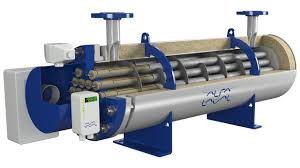Welcome to the world of heat exchange, where innovation meets efficiency! Today, we're diving deep into the fascinating realm of Shell and Tube Heat Exchangers. From their inner workings to practical applications, we'll explore every aspect of these indispensable devices.
Understanding Shell and Tube Heat Exchangers
Shell and Tube Heat Exchangers are ingenious devices designed to facilitate the transfer of heat between two or more fluids. Whether it's cooling water in a power plant or heating oil in a refinery, these heat exchangers play a crucial role in various industrial processes.
How Do Shell and Tube Heat Exchangers Work?
Imagine a cylindrical shell housing a bundle of tubes. One fluid flows through the tubes while another flows around them within the shell. This setup allows for efficient heat transfer between the fluids, thanks to the principle of conduction. Essentially, heat moves from the hotter fluid to the cooler one, balancing temperatures and optimizing energy usage.
The Anatomy of a Shell and Tube Heat Exchanger
Let's break it down:
- Shell: The outer casing that encloses the tube bundle, providing structural support and fluid containment.
- Tubes: Hollow conduits through which one fluid flows, maximizing surface area for heat exchange.
- Tube Sheets: Securely hold the tubes in place within the shell, ensuring proper alignment and preventing leakage.
- Baffles: Internal structures that promote fluid turbulence, enhancing heat transfer efficiency by disrupting laminar flow.
- End Caps: Seal the ends of the shell, directing fluid flow and preventing leakage.
Applications Across Industries
Shell and tube heat exchangers find wide-ranging applications across industries, including:
- Chemical Processing: Cooling or heating chemical compounds during various production processes.
- Power Generation: Condensing steam in turbines, cooling circulating water in nuclear reactors, and more.
- HVAC Systems: Air conditioning, refrigeration, and heat recovery in commercial and residential buildings.
- Oil Refining: Heating crude oil in distillation towers, cooling refined products, and condensing vapor.
- Food and Beverage: Pasteurizing milk, sterilizing equipment, and processing food products.
Pros and Cons
Pros:
- Efficiency: High rates of heat transfer ensure optimal energy usage.
- Versatility: Suitable for a wide range of fluids, temperatures, and pressure conditions.
- Durability: Robust construction materials ensure long-term performance and reliability.
Cons:
- Size: Requires ample space due to the large footprint of the shell and tube bundle.
- Cost: Initial investment and maintenance expenses may be higher compared to other heat exchanger types.
- Cleaning: Tube fouling and maintenance can be labor-intensive, requiring periodic cleaning and inspection.
Shell and Tube Heat Exchangers vs. Other Types
While Shell and Tube Heat Exchangers offer numerous advantages, other types of heat exchangers have their unique strengths. Plate Heat Exchangers, for instance, boast compact designs and faster heat transfer rates, making them ideal for applications with space constraints.
Design Considerations
When designing a Shell and Tube Heat Exchanger, several factors must be taken into account:
- Fluid Properties: Viscosity, density, and thermal conductivity influence heat transfer rates.
- Flow Rates: Balancing flow rates ensures efficient heat exchange without compromising performance.
- Pressure Drop: Minimizing pressure drop across the exchanger enhances overall system efficiency.
- Thermal Performance: Optimizing tube arrangement and surface area maximizes heat transfer efficiency.
Maintenance Tips
To ensure optimal performance and longevity, regular maintenance is essential:
- Cleaning: Periodic cleaning prevents tube fouling and maintains heat transfer efficiency.
- Inspection: Regular inspections detect leaks, corrosion, and other issues early on, preventing costly repairs.
- Preventive Maintenance: Implementing a preventive maintenance schedule minimizes downtime and extends equipment lifespan.
Environmental Impact
Shell and Tube Heat Exchangers play a vital role in promoting environmental sustainability:
- Energy Efficiency: By optimizing heat transfer, these devices help reduce energy consumption and greenhouse gas emissions.
- Resource Conservation: Efficient heat exchange minimizes the need for additional energy resources, preserving natural resources for future generations.
Conclusion
In conclusion, Shell and Tube Heat Exchangers are indispensable components in various industrial processes, offering efficient heat transfer, versatility, and durability. By understanding their principles, applications, and maintenance requirements, industries can harness their full potential to enhance efficiency and sustainability. So, whether it's cooling water in a power plant or heating oil in a refinery, remember the silent yet significant role played by Shell and Tube Heat Exchangers in our daily lives.











![Wireless Connectivity Software Market Size, Share | Statistics [2032]](https://handyclassified.com/uploads/images/202404/image_100x75_661f3be896033.jpg)



